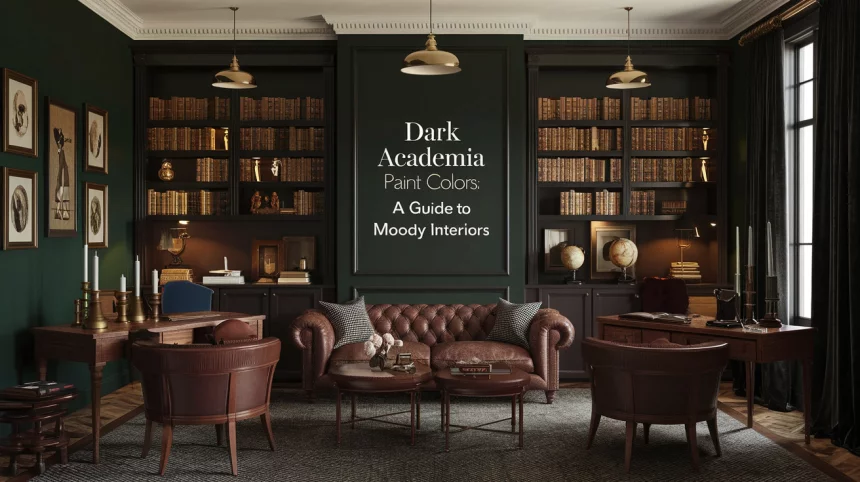Picture walking into a room that feels like stepping into an old library, where shadows dance on walls painted in rich, scholarly tones.
However, picking the right paint colors can feel overwhelming.
If you get one wrong shade, your space might feel gloomy instead of sophisticated.
I’m here to share my favorite paint combinations, which capture the perfect balance of moody and inviting—think less “haunted house” and more “historic study.”
Understanding Dark Academia
Picture an old university library at dusk – that’s the heart of dark academia style.
It’s not just about paint colors; it’s about creating a space that whispers stories of vintage books, late-night studies, and timeless knowledge.
What Makes It Special?
Dark academia blends scholarly charm with cozy comfort.
It’s like turning your room into that perfect corner of an antique bookstore, where leather-bound books meet brass table lamps, and every shadow feels intentional.
The magic lies in two key elements:
- Rich, Deep Colors: Think of shades you’d find in a professor’s study – deep forest greens, warm browns, and burgundies that remind you of old book bindings. These colors don’t just paint walls; they set the stage for quiet contemplation.
- Timeless and Intellectual Atmosphere: Each element should feel like it belongs in a space where great thoughts are born. From the way light falls through curtains to how colors deepen at dusk, every detail adds to that sense of timeless learning.
Remember, we’re not just painting rooms – we’re creating spaces that make you want to curl up with a good book or write your next great idea.
Essential Paint Colors for Dark Academia
Let’s talk about the colors that make dark academia come alive.
After testing countless shades in different spaces, I’ve narrowed down the perfect palette that captures this scholarly style.
1. Deep, Statement-Making Colors
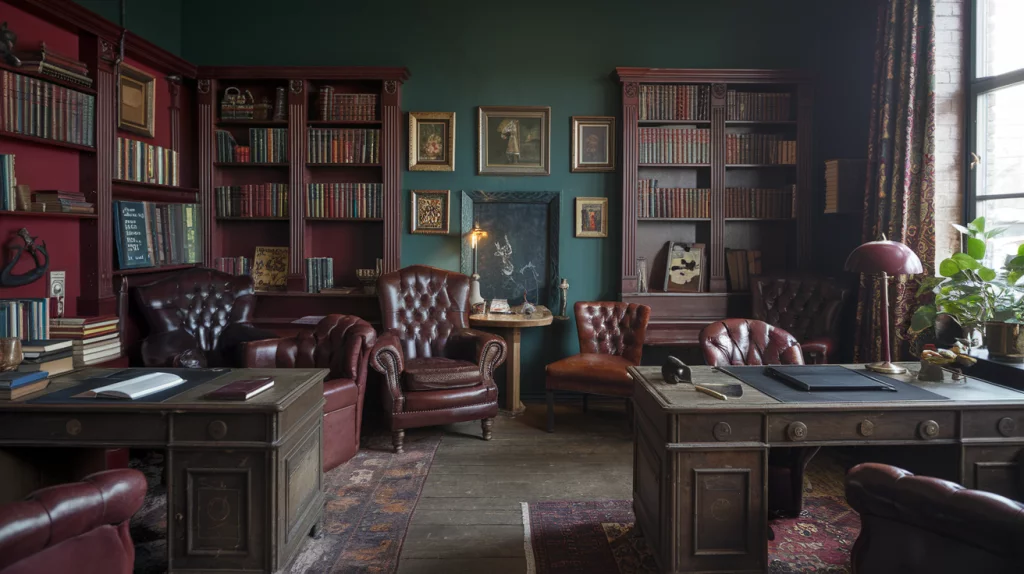
- Dark Green: This isn’t your basic green – it’s a deep, rich shade that reminds you of ivy crawling up old university walls. It works beautifully on a main wall or throughout a study.
- Rich Brown: Picture the color of well-loved leather chairs and aged wooden desks. These brown tones bring natural warmth to any room, making it feel lived-in and comfortable.
- Deep Burgundy: Like the binding of an old book, this shade adds a hint of luxury without feeling showy. It’s perfect for creating a focal point in your space.
2. Light Colors That Balance
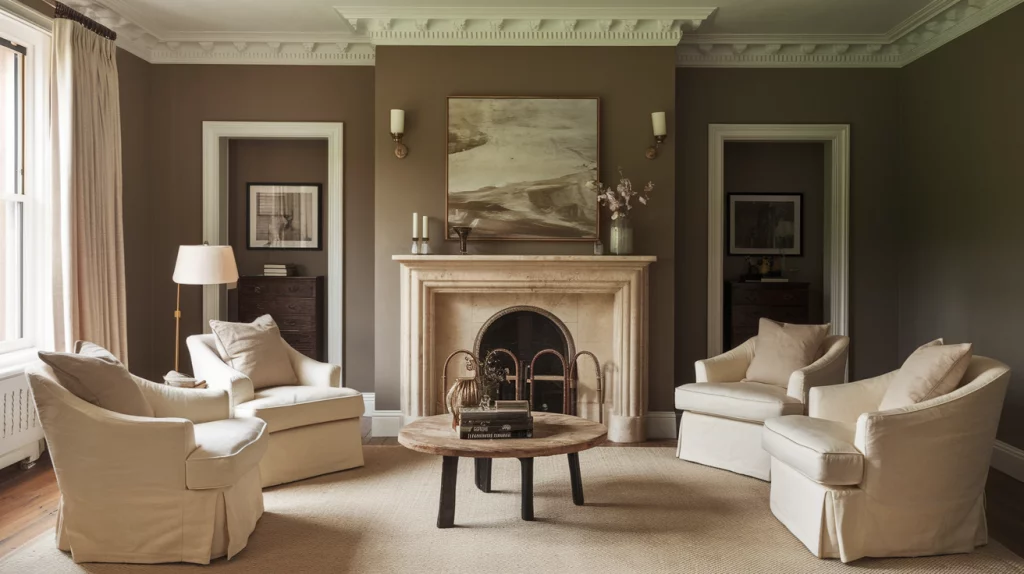
- Warm Gray: This is your breathing room color. It’s dark enough to fit the mood but light enough to keep your space feeling open.
- Soft Beige: This shade, which reminds me of old parchment paper, provides the perfect backdrop for darker furniture and accents.
- Creamy White: Not stark white, but a soft, warm white that brightens without breaking the mood. Great for trim and ceilings.
3. Accent Colors That Add Life
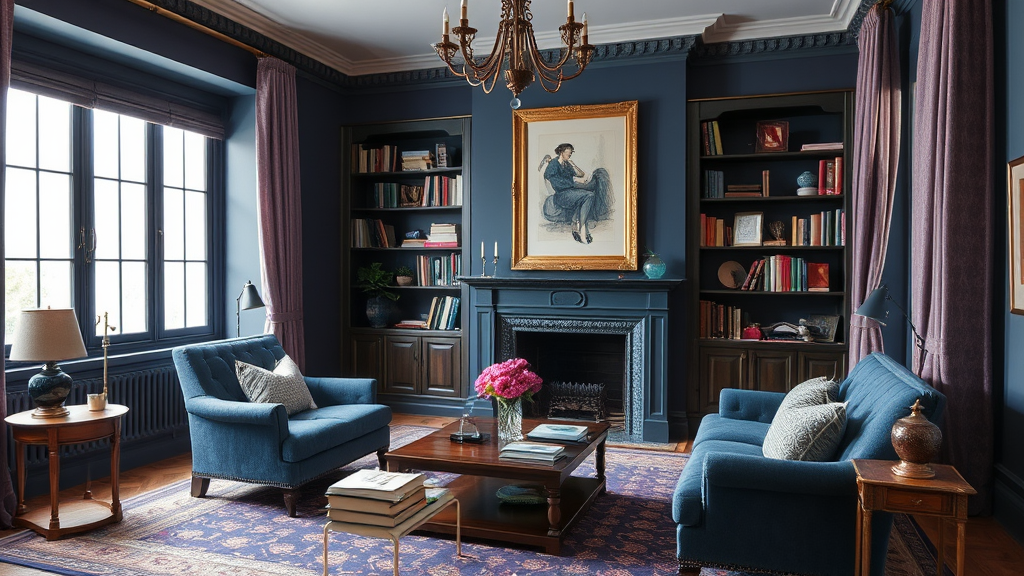
- Deep Blue: Like the evening sky through a library window, this shade brings a calm, studious feeling to smaller areas.
- Vintage Gold: A touch of this color – on frames or in fabrics – adds warmth and catches the light beautifully.
- Muted Purple: Used sparingly, this shade adds depth without taking over. Perfect for small details that catch the eye.
How to Build a Balanced Dark Academia Color Palette
A. Choosing Primary Colors
To establish the foundation of your space, start with one or two rich, deep tones, such as Dark Green, Burgundy, or rich brown.
These colors create a moody, intellectual atmosphere.
B. Incorporating Neutrals
Add neutral shades like Warm Gray or Soft Beige to balance the dark tones.
These colors will soften the intensity of the deeper shades and provide contrast.
C. Accent Colors for Depth
Incorporate small pops of accent colors such as Deep Blue, Mustard Yellow, or Muted Purple.
These colors bring life to the room and enhance the overall aesthetic without overwhelming it.
D. Example Palettes
- Palette 1: Dark Green with Warm Gray, accented by Deep Blue.
- Palette 2: Burgundy with Soft Beige and Muted Purple.
- Palette 3: Rich Brown with Creamy White and Mustard Yellow.
Mixing deep tones, neutrals, and accents allows you to create a balanced and layered Dark Academia color palette that feels cozy and sophisticated.
Practical Tips for Painting Your Dark Academia Space
Getting these moody colors right takes a bit of know-how. Here’s what I’ve learned from turning regular rooms into cozy scholarly retreats:
Test your colors in different spots before committing. What looks perfect at breakfast might feel too dark by dinner.
Dark colors need primer and proper wall prep. Every bump and scratch will show on that deep burgundy wall.
Use a matte or eggshell finish on the walls to keep things sophisticated. For trim, use satin, and for bookshelves, use semi-gloss.
Always paint lighter colors first, then move to darker shades. Two thin coats beat one thick coat every time.
Pro tip: Paint your ceiling a shade lighter than your walls – it opens up the space. Start with one accent wall. It’s amazing how much impact just one richly painted wall can have.
Complementing Dark Academia with Furniture and Accessories
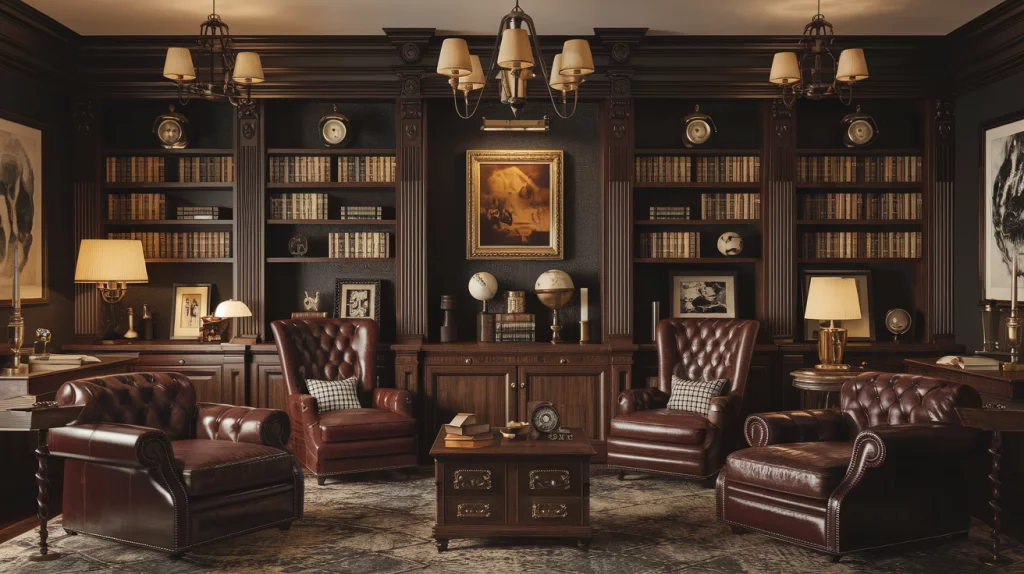
Let me walk you through furnishing your freshly painted space with pieces that bring the scholarly aesthetic to life.
1. Choosing the Right Furniture
Think of each piece as a character in your room’s story.
A dark mahogany desk with brass handles might anchor one corner, while a well-loved leather armchair creates the perfect reading nook. Look for:
- Deep brown wooden bookcases that stretch toward the ceiling
- A tufted velvet sofa in forest green or deep burgundy
- Side tables with ornate details or weathered patina
- An antique writing desk that sparks imagination
- Chairs with curved backs and rich upholstery
2. Creating the Perfect Lighting
Lighting can transform your space from simply dark to delightfully mysterious.
Layer your lighting like this:
- Place brass table lamps with amber-tinted shades on your desk or side tables
- Install vintage-style wall sconces that cast a warm, golden glow
- Add a statement chandelier for drama, but keep the bulbs low-wattage
- Use candles (real or battery-operated) for extra ambiance during evening hours
3. Adding Character Through Accessories
The right accessories make your space feel curated rather than decorated:
- Stack leather-bound books in small piles on tables and shelves
- Display vintage maps in brass frames
- Add an antique globe near your reading chair
- Place old brass desk accessories like letter openers or magnifying glasses
- Hang botanical prints or black-and-white photographs in dark frames
- Include natural elements like dried flowers in antique vases
The key is to make each piece look like it was collected over time rather than bought all at once. Let your space tell a story of curiosity, learning, and timeless sophistication.
Remember, less is often more – you want your room to feel like a well-loved library, not a cluttered antique shop.
Conclusion
Dark academia isn’t just about painting colors—crafting a space that inspires thought and imagination.
Whether you’ve chosen the deep green of ivy-covered halls, the rich brown of aged leather books, or the warm glow of burgundy, each shade helps write your room’s story.
Remember, these moody hues work best when they whisper rather than shout.
Balance dark walls with softer neutrals, add warmth through carefully chosen lighting, and let your space evolve with vintage finds that speak to you.
Ultimately, the perfect dark academia room isn’t about following rules – it’s about creating a retreat where every color, every shadow, and every carefully chosen piece comes together to tell your unique tale of scholarly charm.

